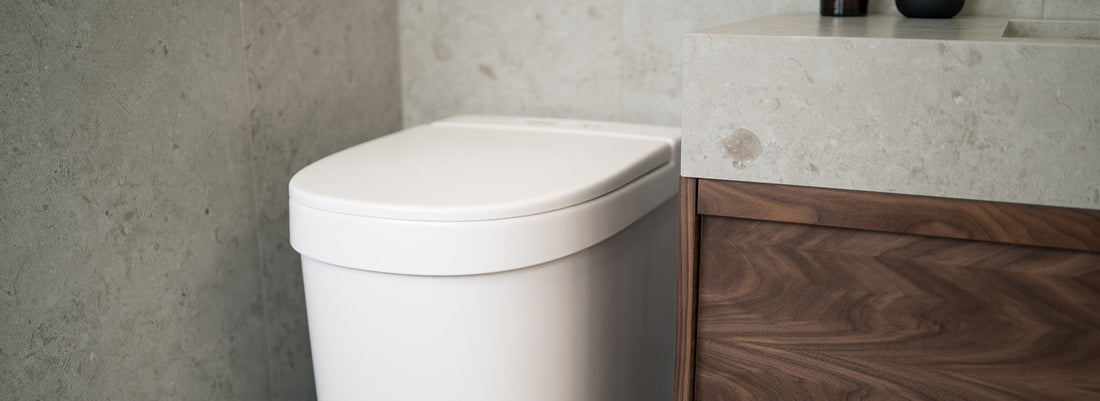
Incinerator Toilets - What Are They?
Share
Incinerating toilets are high-temperature, waterless systems that turn human waste into sterile ash instead of compost. The concept is simple: insert a paper liner, use the toilet, press a button, and after the cycle is complete, only a small amount of clean ash remains.
It’s an elegant and odor-free solution when installed correctly, and in the right environment. At Separett, we have decades of experience with incinerating toilets in our original markets in Sweden and Finland, where they have served tens of thousands of satisfied customers living in remote homes and vacation cabins.
So why aren’t incinerating toilets available from us in the United States, yet? Let’s take a closer look.

How Incinerating Toilets Work
A Separett incinerating toilet uses an electric heating element that scorches the waste at temperatures exceeding 1,000°F. This process completely dries and burns the waste, leaving behind half an ounce of sterile ash per visit.
Each incineration cycle is automatically monitored by advanced sensors. The system includes a platinum-coated catalyst that neutralizes smoke and odor before it exits through the vent pipe. If the temperature or air flow deviates from normal levels, the system automatically shuts down to ensure safety.
The result is a hygienic, odor-free, and waterless solution that requires no composting or external waste handling.
The Benefits of Incinerating Toilets
Incinerating toilets offer several key advantages, particularly for cold-climate or urban installations where composting isn’t practical:
- Completely waterless – no plumbing or drain connection required.
- Hygienic and sterile outcome – all waste is reduced to a small amount of ash.
- No need for composting – ideal where local conditions don’t allow it.
- Automatic operation – modern models handle the full process at the push of a button.
- Odor control – advanced catalytic filtration ensures clean exhaust air.
- For many users in northern Europe, this has been a long-term, convenient sanitation solution.

Cost of Purchase and Operation
Because of their complex heating systems and safety features, incinerating toilets cost about four to five times as much as a Separett Villa or Tiny. While a high-quality urine-diverting toilet generally ranges around a thousand dollars, an incinerating model would cost around $4,000–$5,000.
In daily use, there are ongoing operational costs to consider:
- Paper liners: Each use requires a single-use paper bowl liner, roughly $0.10 per piece.
- Electricity: Each burn cycle uses about 2 kWh of electricity—equivalent to roughly $0.25–$0.30 per use based on the U.S. average electricity price of $0.13–$0.15 per kWh.
- Service and maintenance: Heating elements and filters must occasionally be replaced, adding an average of about $10 per month in accumulated service costs over time.
While the system provides unmatched cleanliness and convenience, the total cost of ownership is notably higher than that of a separating or composting toilet.


The Challenges and Maintenance Needs
The same high temperatures that make the process so effective also place significant stress on the internal components. Over time, the heating coil and other wear-and-tear parts need replacement to maintain efficiency and safety. Regular cleaning of the ash pan and ensuring proper ventilation are also essential to optimal performance.
Another factor to consider is power consumption. Because most of the human waste mass is water, it takes substantial energy to evaporate and boil it away. Typical incineration cycles draw power levels similar to household heating appliances.
While this is manageable in many Scandinavian homes with stable electrical systems, it becomes more complex in regions where off-grid power or voltage stability varies widely.

Why Separett Incinerating Toilets Aren’t Yet in the U.S.
The geographical size and diversity of the U.S. from humid coastlines to high-altitude desertscreates major differences in climate, air pressure, and venting conditions.
Ensuring reliable performance and nationwide technical support under these variations is key before introducing any incinerating toilet system on a larger scale.
For that reason, Separett incinerating toilets are not yet optimized for the U.S. market. However, we continue to evaluate options for a limited regional launch in the future. Our priority is always to ensure that every product we offer is backed by the right infrastructure, safety standards, and customer support.
The Sustainable Perspective
Incinerating toilets completely destroy organic matter, meaning that no nutrients are returned to the soil. While this makes the result entirely sterile and maintenance-free, it differs from the circular approach of urine-diverting and composting toilets, which preserve valuable nutrients like phosphorus for safe reuse in nature.
Both solutions have their place: incineration offers unmatched cleanliness and convenience, while urine diversion and composting support a closed nutrient cycle. At Separett, we see them as complementary technologies, each serving different user needs and environments.

Looking Ahead
Our mission has always been to make sustainable sanitation accessible to everyone—whether through urine-diverting waterless toilets like the Separett Tiny and Villa, or through future innovations such as our next-generation incinerating toilet, Separett Nova.
We’re proud of our Scandinavian engineering heritage and continue to develop systems that balance comfort, safety, and environmental responsibility.
Stay tuned, our story with incinerating toilets is far from over.
